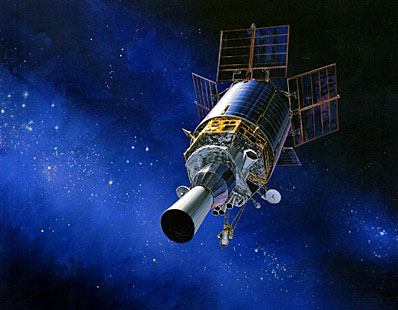The American military is examining two models of spacecraft that will float between satellites and test them, mainly for military espionage purposes, but this technology has many civilian uses, for example, perhaps one day refueling satellites in space

Two hidden small satellites capable of maneuvering in a geosynchronous orbit are being used by the US Defense Administration to test the $400 million missile attack warning satellite that failed in 2008. This is the first time this type of operation has been carried out, thus demonstrating a new capability of the US military.
"This is something completely new," says John Pike, head of the military think tank GlobalSecurity.Org, quoted in an article on Spaceflightnow.com. Pike went on to say that although this operation was used to obtain data on the damaged satellite, such inspections, particularly of enemy satellites and spacecraft, are something the Pentagon has wanted to do since the dawn of the space age. What implications will this new type of spacecraft have on NASA's ability to monitor and repair satellites and spacecraft in orbit in the future?
The DSP 23 missile warning satellite made by the aerospace manufacturer Notrop-Grumman was successfully launched in 2007 but failed immediately after, in early 2008. It was the first launch of the Delta 4 heavy launcher, which was last used again to launch a military satellite on January 17, 2009. The satellites are located At an altitude of 40,230 km above the earth.
At the same time, competitors are also developing these spacecraft. The Mitex spacecraft of Orbital Sciences and Lockheed Martin are part of a project by DARPA - the agency for advanced research projects in the field of defense. When they were launched in 2006, the project involved maneuvering around and examining each of the satellites in geosynchronous orbit. However, no information was received as to whether one or both of the satellites visited one or more of the non-American satellites in this orbit. Every detail about this spacecraft is classified.
Mitex spacecraft are extremely small spacecraft, weighing only 225 kilograms. Most geosynchronous satellites are much larger. Senior officials in the Association of Scientists who are concerned about the global security program say that the Chinese will complain about the action to the UN institutions in Geneva, because they are worried about the consequences of these satellites' capabilities, as well as the fact that the US always complains about the need for transparency in the Chinese space program, but now the US performs covert operations.
While the military aspects of the Mitex spacecraft are unique, it could also provide food for thought for those who speculate what the impact of such satellites will be on NASA and the commercial satellite companies, when it will be possible to scan and perhaps even repair the satellites in orbit.

5 תגובות
I would do it differently.
A few years ago I wrote an article here for the public, "Rekaz-a tiny cosmological robot", a robot that would do all the repair and observation operations listed in this article. However, my idea preferred the method of attaching this robot to each flying spacecraft so that it would be ready and ready for repairs when needed. Such a robot He could have saved the Columbia passengers, opened the antennas stuck in the Galileo spacecraft, etc. The advantage of attaching a tiny shelf robot is that it is cheaper than sending another shuttle.
I don't understand why they don't do it that way.
At the time, my father censored this article mainly on the incomprehensible recommendation of Tal Einbar, and only pressure from the commenters made my father retract it.
I still think and am sure that this could be an excellent start-up project.
You can also see the above article on my Google blog, "Science and Nature - Sabdarmish Yehuda"
good evening
Sabdarmish Yehuda
: )
Thanks sweetie.
I would also link here:
https://www.hayadan.org.il/service_satellites_2203081/
This story sounds really crazy to me, how much information can a small satellite get from an external and even close-up photograph of another satellite?? After all, the whole brain, the computing, the electronics, everything is inside the casing itself, inside the box, if any satellite stopped working, probably one of its internal systems stopped functioning, maybe one of the electronic cards burned, maybe the computer stopped functioning, what would it help to look at the satellite from the outside? (Also on the subject of espionage) It sounds completely stupid to me, I didn't understand the logic here at all.